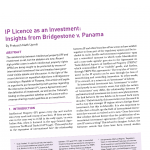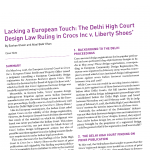Issue #1 – 2018
Modern intellectual property law presents an impressive web of interaction with economy, technology, creative arts and business. We live in a constant stream of impressions from all over the world and from a multitude of diferent sources. Still, we tend to move in familiar patterns or circles, regarding the evolving currents from a mind-set of established perspectives.
We are very happy and proud to present this first issue. Hope you enjoy it!
Customizing Fair Use Transplants
– By Peter K. Yu –
ABSTRACT
In the past decade, policymakers and commentatorsacross the world have called for the introduction ofcopyright reform based on the fair use model in theUnited States. Thus far, Israel, Liberia, Malaysia, thePhilippines, Singapore, South Korea, Sri Lanka andTaiwan have adopted the fair use regime or its closevariants. Other jurisdictions such as Australia, HongKong and Ireland have also advanced proposals tofacilitate such adoption.
This article examines theincreasing efforts to transplant fair use into thecopyright system based on the U.S. model. It beginsby briefly recapturing the strengths and weaknessesof legal transplants.
The article then scrutinizes theongoing effort to transplant fair use from the UnitedStates. Specifically, it identifies eight modalities oftransplantation.
This article concludes with five lessons that can be drawn from studying the ongoing transplant efforts.
IP Licence as an Investment
– By Pratyush Nath Upreti –
The relationship between intellectual property (IP) andinvestment is old, but the debates are new. Recent high profile cases in which intellectual property rights (IPRs) are being sought to be protected by means of international investment law and treaties have generated visible debate and discussion.In the light of the recent decision on expedited objections in BridgestoneLicensing v. Republic of Panama, this article will explore arguments put forwarded by both parties regardingthe interaction between IP Licence Agreements andthe definition of investment, as well as the Tribunal’sfinding on the question whether an IP Licence with arevenue sharing model qualifies as an investment.
Lacking a European Touch
– ByEashan Ghosh and Afzal Badr Khan –
On March 14, 2018, the European General Court in Crocs Inc v. European Union Intellectual Property Office issued a judgment cancelling a European Community design registration for American footwear giants Crocs. This confirmed a decision by the Board of Appeal in June 2016, which had held that Crocs’ signature footwear design was invalidly registered owing to prior publication.
Meanwhile, in faraway India, ‘Crocs’ massive design infringement litigation against seven Indian footwear manufacturers over the same design at issue in the European proceedings, finally came to a head in February 2018 before the Delhi High Court in Crocs Inc v. Liberty Shoes.
Like its European counterparts, the Indian Court ruled against Crocs on the validity of the design registration. However, the European General Court decision also revelaed that much of the material on which its judgment was based was never put before the Indian Court. This raises numerous concerns, not just about the bleak future of Crocs’ Indian design infringement actions but also of possible sanctions against Crocs for failing to meet disclosure requirements under Indian legal procedure.
This note discusses the key findings of the Delhi High Court in Crocs Inc v. Liberty Shoes on the issues of prior publication and originality. The finding on prior publication is incomplete due to its failure to refer to the material disclosed in the European proceedings, as well as the Delhi Court’s marked deviation from established Indian design law in ruling that Crocs’ design lacked originality. It is a decision, that therefore, requires urgent reconsideration on both counts.
The Business of Intellectual Property
– By Marcus Holgersson and Sarah van Santen –
Today intellectual property (IP) comprises an increasing share of firms’ resources and IP rights (IPRs) are important sources of competitiveness. Consequently, there is an increasing interest in how to properly manage IP. IP lawyers need to better understand business decisions and business managers need to better understand IP law. These needs are addressed by a growing area of research on IP management in the intersection between IP law and management.
This article presents a literature review of the broad field of IP management research, with the aim to provide IP law practitioners, managers, and academics with an overview of what we know about IP management, to guide readers in how/where to learn more, and how to move forward in both research and practice. A general conclusion is that the research is rich and quickly growing, but has too little focus and data on strategic IP management issues. Both research and practice need to adopt a more holistic perspective on IP, including different rights and integrating with strategic decision-making.
Working Competition and
Biotechnology Patent Pools
– By Elizaveta Osipchuk –
Patent pools have always been a subject of heated discussions due to their ambiguous position on the market as they bear both anti-competitive and pro-competitive characteristics. On the one hand, they create a common market for licensors and licensees, guarantee access to the industry standards (if any), as well as induce further innovation. On the other hand, they bear a certain risk of violating anti-trust laws.
Patent pools were introduced into life sciences quite recently. Biotechnology patent pools play an immensely important role in providing access to essential, up-to-date medicines for terminal diseases that affect a great number of population in certain countries. They make medicines affordable to the local generic producers in developing and least developed countries who bring the affordable new drug formulations to the market. Furthermore, since modern medicine is largely based on gene patents, pooling is suggested to resolve the patent thicket issue around genetic diagnostics. At this moment, the most successful and global example is the Medicine Patent Pool founded in 2010 by UNITAID.
Patent pools generally encompass patents that protect developed technology. However, for the pharmaceutical industry, it is of major importance that the patent pools facilitate further development of the drugs. This necessity stems from, among other factors, a) the ability of viruses to develop resistance to the treatment, b) scarcity of paediatric drug formulas, and c) the need in fixed dose drug combinations (FDCs) for the treatments requiring simultaneous consumption of several medicines such as antiretroviral drugs.
As patent pools gained more popularity, concern about their adverse impact on competition practices grew as well. Despite the recognized benefits of patent pooling, such as promotion of technical progress and dissemination of technology rights as a special type of goods allowing for an even further increase in manufacturing capacity, the technology transfer block exemption under Regulation 316/2014 is inapplicable to the pooling agreements.
As a result, an examination of the relationship between current EU competition law policy towards patent pools appears to be a particularly relevant and valuable subject for discussion. By establishing whether legal safeguards of the EU anti-trust framework help to reach a healthy balance between the protection of market competition and industrial development, we are able to identify the place of patent pooling in the context of legal solutions for distributing the benefits of health care biotechnologies.






